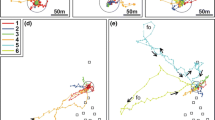Summary
-
1.
A single bee is rewarded with sugar for visits to the centre of a circle of eight landmarks.
-
2.
After training, tests are given in which the sugar is removed and the flight path of the bee recorded as it searches for it. The bee persistently searches a small area in the centre of the circle, demonstrating that it has learnt the position of the sugar relative to the landmarks (Fig. 1A, C).
-
3.
In a second test, three landmarks are removed leaving a semi-circle. The bee now searches a small area “inside” the semi-circle (Fig. 1B, D). In its chosen position none of the landmarks match in size, bearing, or angular separation with the values of the landmarks present during training (Fig. 2), showing that a “retinal matching” model of landmark learning does not predict these results.
-
4.
It is suggested that the bee is not measuring the position of individual landmarks but the overall landmark configuration, a “Gestalt” hypothesis first put forward by van Beusekom (1948). It is hypothesised that the bee moves “inside” the semi-circle in an attempt to have landmarks “surrounding” it as it had when collecting sugar from the centre of the circle.
-
5.
The term “sourroundedness”, a concept similar to the Gestalt idea of “degree of closure” is given a rigid definition. A term describing landmark average distance and a comparison process are also defined, these terms are incorporated into a computer program.
-
6.
The computer program successfully predicts the results of a series of experiments with various training and testing situations (Figs. 1, 5, 6, 7) and some results found by van Beusekom (1948) with the digger wasp (Fig. 8).
-
7.
The model is compared with a “retinal” model and its behaviour in real world situations discussed. It is concluded that the model, although containing some arbitrary features, represents a possible, rigidly defined and testable model of the landmark learning of the bee.
Similar content being viewed by others
References
Anderson, A.M.: Shape perception in the honey-bee. Anim. Behav.25, 67–79 (1977a)
Anderson, A.M.: Parameters determining the attractiveness of stripe patterns in the honey bee. Anim. Behav.25, 80–87 (1977b)
Anderson, A.M.: The influence of pointed regions on the shape preference of honey bees. Anim. Behav.25, 88–94 (1977c)
Beusekom, G. van: Some experiments on the optical orientation inPhilanthus triangulum. Fabr. Behaviour1, 195–225 (1948)
Collett, T.S., Land, M.F.: Visual spatial memory in a hoverfly. J. comp. Physiol.100, 59–84 (1975)
Hertz, M.: Die Organisation des optischen Feldes bei der Biene. I. Z. vergl. Physiol.8, 693–748 (1929a)
Hertz, M.: Die Organisation des optischen Feldes bei der Biene. II. Z. vergl. Physiol.11, 107–145 (1929b)
Hertz, M.: Untersuchungen über den Formensinn der Honigbiene. Naturwissenschaften23, 618–624 (1935)
Hoefer, I., Lindauer, M.: Das Lernverhalten zweier Bienenrassen unter veränderten Orientierungsbedingungen. J. comp. Physiol.99, 119–138 (1975)
Lauer, J., Lindauer, M.: Genetisch fixierte Lerndispositionen bei der Honigbiene. Abh. Akad. Wiss. Mainz, Inf. Org.1, 1–87 (1971)
Manning, A.: Foraging behaviour of bumble bees. Behaviour9, 164–201 (1956)
Ribbands, C.R.: The foraging method of individual honey-bees. J. anim. Ecol.18, 47–66 (1949)
Tinbergen, N.: Über die Orientierung des Bienenwolfes (Philanthus triangulum Fabr.). Z. Vergl. Physiol.21, 699–716 (1932)
Tinbergen, N., Kruyt, W.: Über die Orientierung des Bienenwolfes (Philanthus triangulum Fabr.). III. Die Bevorzugung bestimmter Wegmarken. Z. vergl. Physiol.25, 292–334 (1938)
Wehner, R.: Pattern recognition. In: The compound eye and vision of insects (ed. G.A. Horridge). Oxford: University Press 1975
Author information
Authors and Affiliations
Additional information
I would like to thank Dr. Vernon French and Dr. Hilary Anderson for their suggestions about the construction of the model. I am also indebted to Dr. Bob Wielinga and Bruce Anderson for their criticism of the computer program.
Rights and permissions
About this article
Cite this article
Anderson, A.M. A model for landmark learning in the honey-bee. J. Comp. Physiol. 114, 335–355 (1977). https://doi.org/10.1007/BF00657328
Received:
Issue Date:
DOI: https://doi.org/10.1007/BF00657328




